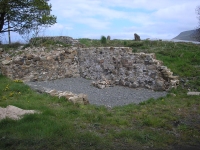


THE CHAPEL OF PORTMOAK
Priory
group Contact: Alistair Smith 01592 840215
‘Where high the heav’nly temple
stands,
The house of God not made with hands,
A great High Priest our nature wears,
The guardian of mankind appears.’
(58th Paraphrase by Michael Bruce)
The Portmoak Priory group is a small group
set up to establish the site of the original Portmoak Priory and is part
of the Kinross-shire Civic Trust. The group aims to establish and research
the original site of Portmoak Priory and provide interpretation for the
benefit of the public.
This site is associated with a chapel of the Culdees, or ‘servants
of God’, that is identified with St Moak who also gave his name
to the parish. A Pictish King provided  financially
for the priory of St. Serf and the chapel of Portmoak and in the mid-11th
century Macbeth added a gift to the Culdees of farm land at Portmoak.
About 1150 King David passed the Priory on St Serf’s Island and
the chapel at Portmoak to the Augustinian canons-regular of St. Andrews
and in 1243 a new chapel built on the same site was dedicated to Saints
Stephen and Moak by Bishop David Bernham.
financially
for the priory of St. Serf and the chapel of Portmoak and in the mid-11th
century Macbeth added a gift to the Culdees of farm land at Portmoak.
About 1150 King David passed the Priory on St Serf’s Island and
the chapel at Portmoak to the Augustinian canons-regular of St. Andrews
and in 1243 a new chapel built on the same site was dedicated to Saints
Stephen and Moak by Bishop David Bernham.
In 1544, when Henry VIII of England threatened the destruction
of the Bishops’ Palace and Cathedral in St Andrews, the endangered
treasures, including the relics of St Andrew, were said to have been temporarily
moved to the chapel of Portmoak for safe keeping. After the Scottish Parliament
abolished papal authority and the mass in 1560, the chapel continued to
serve the parish, but suffered material decline. In 1659, the Presbytery
finally condemned the old chapel building and two years later, a new parish
church was built on the hill above Scotlandwell.
A finely carved Celtic cross-slab, possibly dating from the 9th or 10th
centuries, was found on the site of the old chapel in 1976. It is now
on display in Portmoak Parish Church.
Between the mid 16th-century and 1900 Portmoak was farmed successively by the Whyte, Hoy and Arnott families. A David Arnott was one of the patrons of the Kinnesswood-born ‘Gentle Poet of Lochleven’ Michael Bruce (1746-67) whose poem Daphnis: A Monody describes his friendship with Willie Arnott of Portmoak Farm who died aged 14. The ornately carved tablestone on the grave of young Willie Arnott is one of a small number of gravestones that survives on this site. The last person to be buried in the graveyard here was Willie Arnott’s brother James Arnott, who died in 1758.
Through every political upheaval and every change in ecclesiastical power, God remains the same, yesterday, today and forever.
‘I am the Way the Truth and the
Life
No one comes to the Father except through me.’
John 14:6
‘Whosoever comes to me I will in
no wise cast out.’
John 6:37
The Priory Site will be open to the Public, but because
the site is in the middle of an active airfield, access has to be strictly
controlled. If anyone wishes to go and see the site they MUST only do
so by contacting the members of the Portmoak Priory Group. We will be
very pleased to conduct anyone out to the site. Please do not turn up
at the airfield and expect to either drive out to the site or ask the
members of the SGU to do so. Our agreement, the PPGs, with the SGU is
that we will strictly control access and no one else.
Work in progress:-
 |
 |
 |
We would like to take this opportunity of thanking the Scottish Gliding Union for all the support they have given us during our endeavours to establish the site. They have granted us free access to the airfield and taken full interest in the work we are doing.
